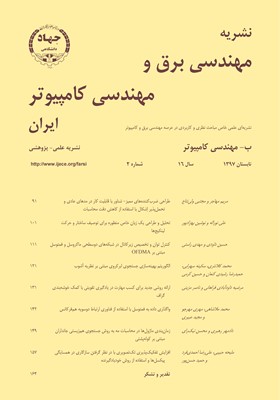الگوریتم بهینهسازی جستجوی ابرکروی مبتنی بر نظریه آشوب
محورهای موضوعی : مهندسی برق و کامپیوتر
محمد کلانتری
1
*
,
سکینه سهرابی
2
,
حمیدرضا رشیدی کنعان
3
![]() ,
حسین کرمی
4
,
حسین کرمی
4
1 - دانشگاه تربیت دبیر شهید رجایی
2 - دانشگاه تربیت دبیر شهید رجایی
3 - دانشگاه تربیت دبیر شهید رجایی
4 - دانشگاه صنعتی امیرکبیر
کلید واژه: الگوریتم فراابتکاری مبتنی بر نظریه آشوبالگوریتم جستجوی ابرکرویمسئله بهینهسازی نظریه آشوب,
چکیده مقاله :
در این مقاله الگوریتم بهینهسازی جستجوی ابرکروی با استفاده از نظریه آشوب ارائه میشود که ضعف الگوریتم بهینهسازی جستجوی ابرکروی استاندارد، یعنی سرعت همگرایی و افزایش تعداد تکرار اجرای الگوریتم برای رسیدن به جواب بهینه را برطرف می نماید. در الگوریتم پیشنهادی، در گام ایجاد ذرات و گام جستجو، مقادیر حاصل از دو نگاشت چبیشف و لیبوویچ، جایگزین مقادیر تصادفی موجود در الگوریتم استاندارد میشود که این امر باعث بهبود نتایج حاصل از اجرای الگوریتم شده و انحراف معیار نتایج را کاهش میدهد. نتایج شبیهسازی بر روی توابع محک استاندارد نشان میدهد که الگوریتم پیشنهادی ضمن برخورداری از همگرایی سریعتر، دقت بیشتری نیز در یافتن جواب بهینه نسبت به الگوریتم جستجوی ابرکروی استاندارد و همچنین الگوریتمهای بهینهسازی دیگر نظیر ژنتیک، ازدحام ذرات و الگوریتم جستجوی هارمونی دارد.
A Hyper Spherical Search (HSS) optimization algorithm based on chaos theory is proposed that resolves the weakness of the standard HSS optimization algorithm including the speed of convergence and the sequential increment in the number of algorithm iterations to achieve the optimal solution. For this, in the particle initiation and search steps of the proposed algorithm, random values used in the standard algorithm are replaced with the values of two mappings, Chebyshev and Liebovitch, that makes the results of the proposed algorithm definite and decreases their standard deviation. The simulation results on the standard benchmark functions show that the proposed algorithm not only has faster convergence, but also acts as a more accurate search algorithm to find the optimal solution in comparison to standard hyper spherical search algorithm and some other optimization algorithms such as genetic, particle swarm, and harmony search algorithm.
[1] X. S. Yang, Nature-Inspired Metaheuristic Algorithms, Luniver Press, 2010.
[2] S. A. Ahmadi, "Human behavior-based optimization: a novel metaheuristic approach to solve complex optimization problems," Neural Computing and Applications, vol. 28, no. 1, pp. 233-244, Dec. 2017.
[3] A. H. Gandomi, A. H. Alavi, and S. Talatahari, "Structural optimization using krill herd algorithm," Swarm Intelligence and Bio-Inspired Computation: Theory and Applications, pp. 335-349, 2013.
[4] R. Nallakumar, N. Sengottaiyan, and K. S. Priya, "A survey on scheduling and the attributes of task scheduling in the cloud," Int. J. Adv. Res. Comput. Commun. Eng., vol. 3, no. 10, pp. 8167-8171, Oct. 2014.
[5] C. W. Tsai and J. J. Rodrigues, "Metaheuristic scheduling for cloud: a survey," IEEE Systems J., vol. 8, no. 1, pp. 279-291, Mar. 2014.
[6] F. Dong, J. Luo, L. Gao, and L. Ge, "A grid task scheduling algorithm based on QoS priority grouping," in Proc. 5th Int. Conf on Grid and Cooperative Computing, GCC’06, pp. 58-61, Hunan, China, 21-23 Oct. 2006.
[7] U. Parlitz and L. Junge, "Synchronization of chaotic systems," in Proc. European Control Conf., ECC’99, pp. 4637-4642, Karlsruhe, Germany, 31 Aug.-3 Sept. 1999.
[8] D. Yang, G. Li, and G. Cheng, "On the efficiency of chaos optimization algorithms for global optimization," Chaos, Solitons & Fractals, vol. 34, no. 4, pp. 1366-1375, Nov. 2007.
[9] B. Alatas, "Chaotic harmony search algorithms," Applied Mathematics and Computation, vol. 216, no. 9, pp. 2687-2699, Jul. 2010.
[10] A. H. Gandomi, G. J. Yun, X. S. Yang, and S. Talatahari, "Chaos-enhanced accelerated particle swarm optimization," Communications in Nonlinear Science and Numerical Simulation, vol. 18, no. 2, pp. 327-340, Feb. 2013.
[11] B. Alatas, "Chaotic bee colony algorithms for global numerical optimization," Expert Systems with Applications, vol. 37, no. 8, pp. 5682-5687, Aug. 2010.
[12] A. H. Gandomi and X. S. Yang, "Chaotic bat algorithm," J. of Computational Science, vol. 5, no. 2, pp. 224-232, Mar. 2014.
[13] H. Karami, M. J. Sanjari, and G. B. Gharehpetian, "Hyper-spherical search (HSS) algorithm: a novel meta-heuristic algorithm to optimize nonlinear functions," Neural Computing and Applications, vol. 25, no. 6, pp. 1455-1465, Nov. 2014.
[14] P. Arena, R. Caponetto, L. Fortuna, A. Rizzo, and M. La Rosa, "Self-organization in nonrecurrent complex systems," International J. of Bifurcation and Chaos, vol. 10, no. 5, pp. 1115-1125, May 2000.
[15] B. Alatas, E. Akin, and A. B. Ozer, "Chaos embedded particle swarm optimization algorithms," Chaos, Solitons & Fractals, vol. 40, no. 4, pp. 1715-1734, May 2009.
[16] E. N. Lorenz, "Deterministic nonperiodic flow," J. of the Atmospheric Sciences, vol. 20, no. 2, pp. 130-141, Mar. 1963.
[17] L. Dos Santos Coelho and V. C. Mariani, "Use of chaotic sequences in a biologically inspired algorithm for engineering design optimization," Expert Systems with Applications, vol. 34, no. 3, pp. 1905-1913, Apr. 2008.
[18] S. Das and P. N. Suganthan, Problem Definitions and Evaluation Criteria for CEC 2011 Competition on Testing Evolutionary Algorithms on Real World Optimization Problems, Technical Report, Dec. 2010.

